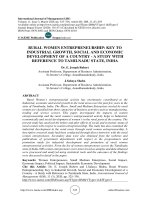Economic growth and economic development 395
Bạn đang xem bản rút gọn của tài liệu. Xem và tải ngay bản đầy đủ của tài liệu tại đây (131.25 KB, 1 trang )
Introduction to Modern Economic Growth
will grow in response to a gap between this rate of return and the discount rate,
which is related to the elasticity of marginal utility of consumption, εu (c (t)).
Notice that εu (c (t)) is not only the elasticity of marginal utility, but even more
importantly, it is the inverse of the intertemporal elasticity of substitution, which
plays a crucial role in most macro models. The intertemporal elasticity of substitution regulates the willingness of individuals to substitute consumption (or labor or
any other attribute that yields utility) over time. The elasticity between the dates
t and s > t is defined as
σ u (t, s) = −
As s ↓ t, we have
(8.16)
d log (c (s) /c (t))
.
d log (u0 (c (s)) /u0 (c (t)))
1
u0 (c (t))
=
.
σ u (t, s) → σ u (t) = − 00
u (c (t)) c (t)
εu (c (t))
This is not surprising, since the concavity of the utility function u (·)–or equivalently, the elasticity of marginal utility–determines how willing individuals are to
substitute consumption over time.
Next, integrating (8.12), we have
ả
à Z t
(r (s) ) ds
à (t) = à (0) exp
0
à Z t
ả
0
(r (s) ) ds ,
= u (c (0)) exp −
0
where the second line uses the first optimality condition of the current-value Hamiltonian at time t = 0. Now substituting into the transversality condition, we have
∙
µ Z t
ảá
0
(r (s) ) ds
= 0,
lim exp ( ( − n) t) a (t) u (c (0)) exp −
t→∞
0
∙
µ Z t
ảá
(r (s) n) ds
= 0,
lim a (t) exp −
t→∞
0
which implies that the strict no-Ponzi condition, (8.11) has to hold. Also, for future reference, notes that, since a (t) = k (t), the transversality condition is also
equivalent to
∙
µ Z t
ả
á
(r (s) n) ds k (t) = 0,
lim exp −
t→∞
0
381









